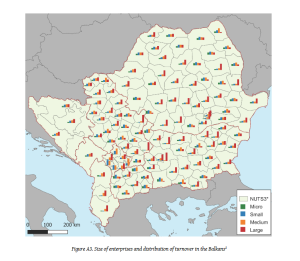The firm geography of Central and Eastern Europe
and the Western Balkans
Judit Berkes – Ádám Páthy – Ildikó Egyed – Szilárd Rácz
This article investigates the spatial distribution of firms across 15 countries in Central and Eastern Europe and the Western Balkans using data from the Orbis Europe database. By analyzing over 300,000 enterprises with more than ten employees, the study explores firm size, turnover, and sectoral characteristics across various types of regions, including capitals, urban agglomerations, and rural areas. The authors aim to reveal regional economic patterns shaped by historical, political, and institutional differences between post-socialist and Western economies.
Why should we focus on this region and this topic?
 The Central and Eastern European and Western Balkan countries represent a dynamic but highly heterogeneous macro-region within the EU and its neighborhood, characterized by persistent development disparities, post-socialist transformation legacies, and external economic dependencies. Understanding the spatial structure of enterprise activity in this region is key to designing evidence-based policies that promote balanced territorial development, economic resilience, and sustainable competitiveness.
The Central and Eastern European and Western Balkan countries represent a dynamic but highly heterogeneous macro-region within the EU and its neighborhood, characterized by persistent development disparities, post-socialist transformation legacies, and external economic dependencies. Understanding the spatial structure of enterprise activity in this region is key to designing evidence-based policies that promote balanced territorial development, economic resilience, and sustainable competitiveness.
The paper is structured around three key research questions:
(1) Are there identifiable patterns in the geographical distribution of large firms by size?
(2) Can regional space be meaningfully divided based on firms’ activities?
(3) Is there a spatial concentration of knowledge- and technology-intensive sectors?
Methodologically, the study employs descriptive statistics and spatial indicators such as location quotients and LISA cluster analysis at the NUTS3 level. Results highlight significant spatial disparities in firm distribution and sectoral specialization, with capital cities and their agglomerations concentrating high-value-added services, while rural areas remain dominated by low-tech and low-efficiency industries.
The paper emphasizes the specific development challenges of smaller urban centers, especially in countries lacking a strong second-tier city network. The authors argue for regionally tailored, sustainable economic models that move beyond FDI-driven growth and focus on endogenous resources and capacities.
The findings offer insights for policy strategies aimed at reducing regional disparities and strengthening economic resilience in Central and Eastern Europe and the Western Balkans.
 The firm geography of Central and Eastern Europe and the Western Balkans – Judit Berkes – Ádám Páthy – Ildikó Egyed – Szilárd Rácz – Journal of Urban and Regional Analysis – Volume 17, Issue 1, 2025
The firm geography of Central and Eastern Europe and the Western Balkans – Judit Berkes – Ádám Páthy – Ildikó Egyed – Szilárd Rácz – Journal of Urban and Regional Analysis – Volume 17, Issue 1, 2025
https://doi.org/10.37043/JURA.2025.17.1.1


